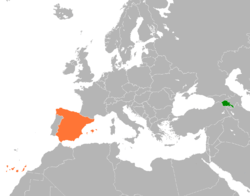Armenia–Spain relations
Armenia–Spain relations refers to the diplomatic relations between Armenia and Spain. The importance of relations centers on the history of Armenians migration to Spain. Approximately 40,000 Armenians and their descendants reside in Spain.[1] Both nations are members of the Council of Europe.
 | |
Armenia |
Spain |
|---|---|
Country comparison
| Coat of arms |  |
.svg.png) |
| Population | 3,262,200 | 46,354,321 |
| Area | 29,743 km² (11,484 sq mi) | 505,990 km² (195,360 sq mi) |
| Population density | 108.4/km² (280.7/sq mi) | 92/km² (238/sq mi) |
| Capital | Yerevan | Madrid |
| Largest city | Yerevan – 1,121,900 (1,230,000 Metro) | Madrid – 3,141,991 (6,700,000 Metro) |
| Government | Unitary parliamentary republic | Unitary parliamentary constitutional monarchy with regional devolved powers |
| Current Leader | President Armen Sarkissian Prime Minister Nikol Pashinyan |
Monarch Felipe VI Prime Minister Pedro Sánchez |
| Official languages | Armenian | Spanish |
| Main religions | 99% Christian, 1% Yazidism | 68% Catholic Christians, 27% not religious, 2% other religions |
| Ethnic groups | 97.9% Armenians, 1.3% Yazidis, 0.5% Russians, 0.3% Others | 88% Native-born Spanish citizens, 12% immigrants (57% of them from Spain's former colonies in Latin America, the rest are |
| GDP (nominal) | US$10.106 billion ($3,032 per capita) | US$1.864 trillion, ($40,290 per capita) |
History

Early relations
The first initial contact between Armenia and Spain took place in 1382 when deposed King Leo V from the Armenian Kingdom of Cilicia arrived to Spain seeking assistance from Spanish King John I of Castile to regain his kingdom. In Spain, Leo V received the title of Lord of Madrid and stayed in Spain until 1390 when King John I of Castile died.[1] Throughout the centuries, Armenians arrived to Spain escaping war and uncertainties in their home country. Some Armenians partook in the age of exploration for Spain in the late 1400s and early 1500s.[1]
During the Armenian Genocide in 1915, most Armenians did not travel Spain, but instead went to either France or former Spanish territories of Argentina and Uruguay. On 26 December 1991, Armenia regained independence after the Dissolution of the Soviet Union. On 27 May 1992, Armenia and Spain established diplomatic relations.[2]
Modern relations
Since independence, over 20,000 Armenians have immigrated to Spain.[3] In 2003, Spain opened an honorary consulate in Yerevan. In August 2010, Armenia opened a resident embassy in Madrid.[4] In recent years, five Spanish provinces have recognized the Armenian genocide (Aragon, Balearic Islands, Basque Country, Catalonia and Navarre).[5] In 2010, a memorial was erected in Mislata, Valencia, the first monument commemorating the Armenian genocide in Spain.[6]
High-level visits
High-level visits from Armenia to Spain[2][4]
- Foreign Minister Miguel Ángel Moratinos (June 2007 & March 2010)
- Foreign Minister José Manuel García-Margallo (April 2014)
High-level visits from Spain to Armenia
- Foreign Minister Vartan Oskanian (November 2000 & November 2007)
- Foreign Minister Eduard Nalbandyan (May & December 2010, June 2013)
Bilateral agreements
Both nations have signed several bilateral agreements, such as an Agreement on the reciprocal Promotion and Protection of Investments (1990); Agreement on international transportation by road (2000); Memorandum of Understanding in Tourism (2013); Agreement on the Avoidance of Double Taxation and Tax Evasion (2010) and an Agreement on Cultural, Educational and Scientific Cooperation (2013).[2]
Trade
In 2015, trade between Armenia and Spain totaled €55.8 million Euros.[2] Armenia's main exports to Spain include: ores, slag and ash. Spain's main exports to Armenia include: ceramic products, preserved fruit and vegetables, perfume, rubber and meat.[2] Spanish multi-national company, Zara operates in Armenia.
Resident diplomatic missions
See also
References
- Cien Años del Genocidio Armenio (in Spanish)
- Bilateral relations between Spain and Armenia (in Spanish)
- Karen Mardanyan: “En España estamos dando ahora los pasos que los armenios dieron en Francia en los años veinte” (in Spanish)
- Bilateral relations between Armenia and Spain
- Spanish lawmakers reportedly fail to recognize Armenian Genocide
- Mislata inaugura la primera escultura que simboliza la amistad entre España y Armenia
- Embassy of Armenia in Spain
- Embassy of Spain in Russia